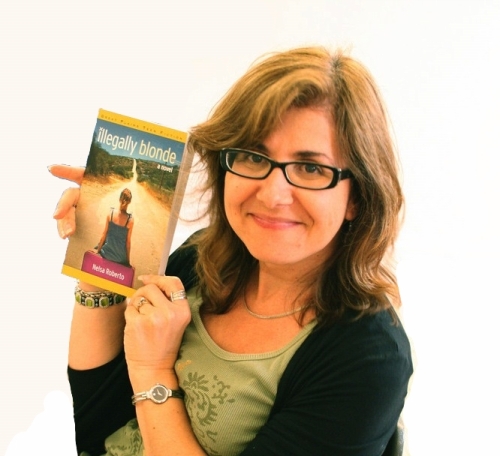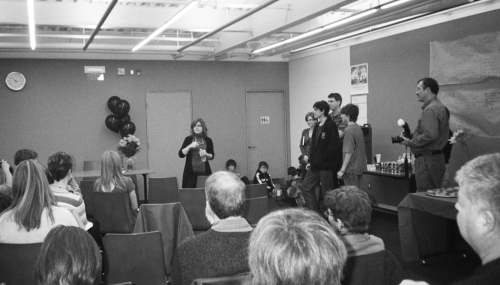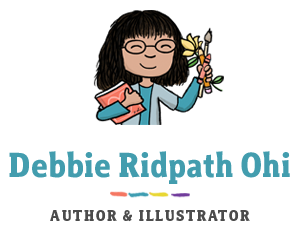
I met YA author Nelsa Roberto through the Toronto Middle Grade and Young Adult group (a.k.a. Torkidlit). Nelsa’s one of those people who makes you feel comfortable right away. She’s smart, she’s funny, she speaks her mind.
Nelsa’s young adult novel ILLEGALLY BLONDE debuted in March and I really enjoyed it. Told with wry wit yet with compassion, the story follows Portugese-Canadian 17-year-old Lucy do Amaral, who discovers that her immigrant parents are illegal workers on the verge of being deported back to Portugal.
I especially enjoyed watching Lucy’s character develop through the story, from a miserable and self-absorbed teen to a young adult whose relationships with friends and family evolve along with her own life perspective.
And now I -so- want to go to Portugal someday.

Some questions for Nelsa…
How long have you been writing?
I started writing out of the blue a little over seven years ago. I was facing a particularly intimidating birthday (let’s not ask which one, shall we? It still gives me nightmares) and I realized I wanted to do more with my life creatively than giving birth and making cupcakes.
While my children are amazing and I’m inspired by them daily, I needed to do something that was solely mine – something that I crafted alone out of the ether. For some reason, I chose to sit down and write my kids a book. It was, of course, awful (I discovered I do not have a historical MG voice!) but I’m so glad that notion to do it came upon me. I haven’t regretted it for a second.
What was your first sale & how did you make it?
By 2006, I’d written a few practice books – most were romance. I’d come close with agents getting good feedback, requests for partials and fulls but nothing came of them. Stephanie, my CP, suggested I try writing in first person.
I was really leery of it – had only done 3rd person before. But when I used it to pen ILLEGALLY BLONDE – my first YA – it fit like a custom made suit. I finished IB by December 2006, began querying agents, got immediate interest and requests for fulls from several and signed with the Carolyn Swayze Agency (out of B.C.) in February 2007.
The book went out on submission and we got very close with two houses but were turned down at acquisitions at both. At the time I wasn’t aware how hard it was to even get to acquisition meetings – I just figured it wasn’t meant to be. In fact, I had my first writing crisis in December 2008 where I was seriously considering giving it all up.
I told my agents I was going to try and figure out what I wanted to do over the holidays. My agents suggested we go to some independent Canadian presses and, thinking nothing would come of it since I was convinced I wasn’t ever going to have what it takes to get a book published, I said sure.
In February 2009 only 3 weeks after it was submitted, Great Plains Teen Fictionoffered to publish ILLEGALLY BLONDE. Needless to say, I was shocked. Still am.
What inspired you to write Illegally Blonde?
In March of 2006 there were several news stories about an Immigration Canada crackdown on illegal Portuguese workers in Toronto. Being of Portuguese-Canadian descent I was immediately intrigued by this whole segment of the population that was living normal, go-to-work, pay the bills, kids in school lives but yet were undocumented and had been so for years.
When I saw a picture in the local paper of a teen girl helping her mom pack up dishes because they had to leave the country in a couple of weeks I thought “How would I feel if I was this girl, being told I had to leave the country I grew up in – that I identified with – and had to leave my friends and school to go live in a small, remote village I hadn’t seen since I was a baby?” From that question, was born Lucy do Amaral, the heroine of ILLEGALLY BLONDE.
Did you write an outline first? If so, how detailed?
My process is a combination of plotter and pantser so I did do an outline for about the first half of the book. I also knew what the ending would be. That middle was more fluid (probably why I set the book aside for a couple of months while I stewed over what would happen to Lucy once she got to Portugal and what she would do to get back).
My first drafts are all in long-hand allowing me not to self-edit like I do when typing. My outlines are more general things (like back cover blurbs) but I do recall for ILLEGALLY BLONDE that I spent a bit of time going through the chapter by chapter plot events for the first hundred pages or so.
But normally I don’t do charts or precise chapter by chapter outlines for the entire book. I have written synopses for various books in the past but I find it pretty much taps out the creativity when I start to write the book. A lot of times as I’m writing I get more ideas and I scribble them in the sidelines of my journal – again messy and disorganized but it works for me.
By this point in my writing life, I generally do a one or two page, general description of the book (in back cover book language) so my agent can see whether this idea is worthwhile. Then what I really try to spend time on is the “why” of my characters. What do they want the most and why? If I’ve got that nailed down – the book really does pull together quite nicely.
You mention “agents” rather than “agent” in one of your earlier answers — do you have more than one agent?
I work with Kris Rothstein, an Associate Agent as well as the principal agent, Carolyn Swayze. Kris takes on more of the editorial review and ms revisions while Carolyn deals with the contract/sales/international rights side of things.
What kind of response have you had from the Portuguese community about ILLEGALLY BLONDE?
Well, right around the time of my book launch I got an email from an OMNI TVPortuguese language edition reporter who’d seen my press release about the book launch and was intrigued by the premise of a book on the deportees. I actually went and did a real live TV interview at the studios – and spoke in Portuguese! Yikes. There may be more follow-up from that – fingers crossed.
Prior to the book release, the Portuguese language studies department at York University invited me to speak on a panel with (Giller nominated) Anthony de Sa, Paulo da Costa and Rachel Sa – all writers of Portuguese descent – to talk about the effects the Portuguese diaspora had on our writing.
I’ve been very lucky to have Mr. de Sa be such a wonderful and encouraging person and I hope more writers of Portuguese descent appear over the next few years to share stories. I don’t know of any YA books with main characters from my cultural background so I hope ILLEGALLY BLONDE can fill a small niche there.
I’m hopeful that some schools who have a student population that are of this heritage (or any school with a large immigrant population) might discover ILLEGALLY BLONDE and I plan to connect with them.
Interesting to hear that you did your first drafts all in long-hand. Do you still do that for newer book projects?
Yes. All my projects start out in long-hand. I think it will always be that way for me. I find I don’t self-edit myself during that first draft if I see a messy scrawl on a page – it can be crap because it looks like crap. But, boy, that nice, clean computer screen? The words have to be perfect there. I love revising both on the screen and when it’s printed out on paper. Revising is my true love!
Have your children read your book? If so, what do they think?
I have two teen daughters (and one 10 year old boy) so you’d think I’d use them to read through all my drafts. Nope. I have this phobia about anyone in my family reading my stuff unless it gets to print. So, only when BLONDE was published and I handed them a copy were they able to read it.
Both my daughters have now read it and said they enjoyed it (I believe them since they are always brutally honest with me) but they did say they were completely stressed over Lucy’s sometimes wrong-headed decisions. My youngest daughter (14) said she was getting quite irritated with some of the choices my MC made when faced with deportation. “Mom! Why did she DO that? I’d never do something like that.”
I said, “Well, honey, if you were in this situation all you’d do is go along to Portugal and sit and mope about your situation. Now how interesting would it be to read about sensible actions and decisions?” She acknowledged that fiction is fiction because reality can sometimes be incredibly boring.
How did you find out about Torkidlit?
Oh! I thank the heavens daily that I became a member of the Verla Kay Blueboards, met the fabulous Hélène Boudreau there and she invited me to come out and meet these great MG/YA authors from the Toronto area.
If not for her, I’d never have met such a wonderful, supportive group (and if not for meeting you, Debbie, I’d never have joined Twitter. Who knew I’d like it so much??) This has been the best part of the writing journey – meeting great people I’d never have gotten to know otherwise.
What are your current/upcoming projects?
Well, I’ve completed another contemporary coming-of-age book called THE BREAK. It’s about a teen girl who has to look after her grandmother during the March Break but the beloved grandma is slowly slipping into dementia.The other book is a YA paranormal. I wrote it in 2008 but I revised it earlier this year and it is now in submission. I have great hopes for both of them!
How did you find your agents?
No amazing story here – I did what thousands of other writers do, I made a list of agents both in Canada and U.S. that I felt were reputable, had YA experience and represented some authors I was aware of, wrote up a (hopefully) killer query and sent it off. Carolyn and Kris were very enthusiastic about ILLEGALLY BLONDE and I’ve felt that support throughout the long process of selling it.
What is your typical writing process for a book? e.g. do you outline? daily goals? etc.
A little while ago I wrote a blog post on this very topic (along with several other writers we linked to each other’s posts). Basically, I think I’m a hybrid writer – part pantser, part plotter but I do go through some definite stages in my process. It works for me but as for daily goals? Nuh-uh. Kiss of guilt death for me – and I have enough guilt in my life already thank you very much (I’m dropping so many balls I don’t need to feel bad about not hitting a thousand words a day on top of it).
I may go days where I write a couple of paragraphs but then I make it up with a whopping ten pager another day. But it does help to say to myself, by such and such a date I’d like to have 30,000 words written.
It takes me anywhere from 4 to 6 months to write a book if it’s going smoothly (that means a first draft plus 2 or 3 heavy revisions) so I can break that time period into chunks of a novel.
What advice do you have for hopeful writers?
Never, ever, EVER, give up. I’m a great believer in perserverance. This is my formula: Passion + Persistence = Published. Honestly, if you love this writing gig enough why on earth would you ever give up on it?
TO FIND OUT MORE ABOUT NELSA:
Out Of The Woodwork: Nelsa’s blog
Interview with Nelsa Roberto by Claudia Osmond
For more insights from book creators, see my Inkygirl Interview Archives and Advice For Young Writers And Illustrators From Book Creators.

